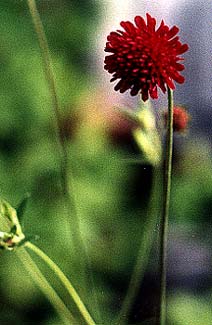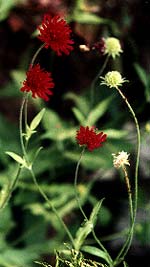
'Egyptian Rose' Knautia; or,
Macedonian Scabious
"Oh grant me a house by the beach of a bay,
Where the waves can be surly in winter, & play
With the sea-weed in summer, ye bountiful powers!
And I'd leave all the hurry, the noise, & the fray,
For a house full of books, & a garden of flowers."
-Andrew Lang
(1844-1912)
(1844-1912)
Apparently the wildflower Knautia macedonica has no widely used common name among gardeners, except for its genus name Knautia, though it is less often found in catalogs by its species name Macedonica or by names apparently devised by the catalog authors, such as Scarlet Pincushion Flower or Macedonian Scabious, due to its resemblance to Scabiosa sp, to which it is closely related.
 In the Netherlands its common name is Beemdkroon, which I wouldn't have a clue how to pronounce, but seems to mean "Meadow Scabiousa." It doubtless has many regional names throughout Central Europe where, in the manner of its relative Scabiosa arvensis, it has been valued since medieval times as a culinary & medicinal herb gathered from the wild. But among English-speaking gardeners, the closest thing to a concensus as to a common name is simply the genus name, after a 17th Century Saxon botanist, Dr. Christopher Knaut (1638-1694).
In the Netherlands its common name is Beemdkroon, which I wouldn't have a clue how to pronounce, but seems to mean "Meadow Scabiousa." It doubtless has many regional names throughout Central Europe where, in the manner of its relative Scabiosa arvensis, it has been valued since medieval times as a culinary & medicinal herb gathered from the wild. But among English-speaking gardeners, the closest thing to a concensus as to a common name is simply the genus name, after a 17th Century Saxon botanist, Dr. Christopher Knaut (1638-1694). Our Knautia is the cultivar 'Egyptian Rose,' planted by a picket fence near the Lionshead Maple. It produces a great many deep wine-red one-inch pincushion flowers. These flowers hold their color well if dried to be used in winter floral arrangements. The fresh flowers last well in bouquets.
The perennial basal leaves are usually about two or occasionally three feet tall but the flowers, on wiry stems, can raise their heads to six feet high. The foliage usually shows two distinct kinds of leaves, being more deeply divided higher on the clump than at the basal portion.
The blooms begin in Spring & with deadheading will reliably continue until first frost; ours is still in lively blossom in October. A slow release fertilizing early each summer will suffice.
Knautia wants lots of sun but will tolerate a little shade, & it requires well-draining soil. Once established as a sturdy clump, it will be fairly drought tolerant with just occasional deep waterings. Though it isn't fussy as to soil types, an acid soil rich in organic matter particulary excites it.
It does not require pruning though any foliage that lasts deep into winter will need trimming back before spring. It's individual clumps are not notably long-lived, but may self-seed & naturalize in the garden.